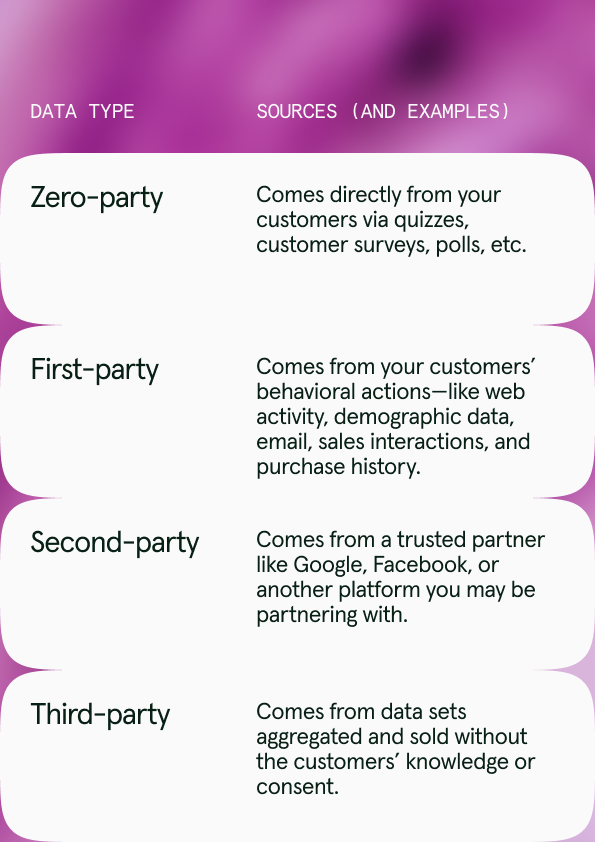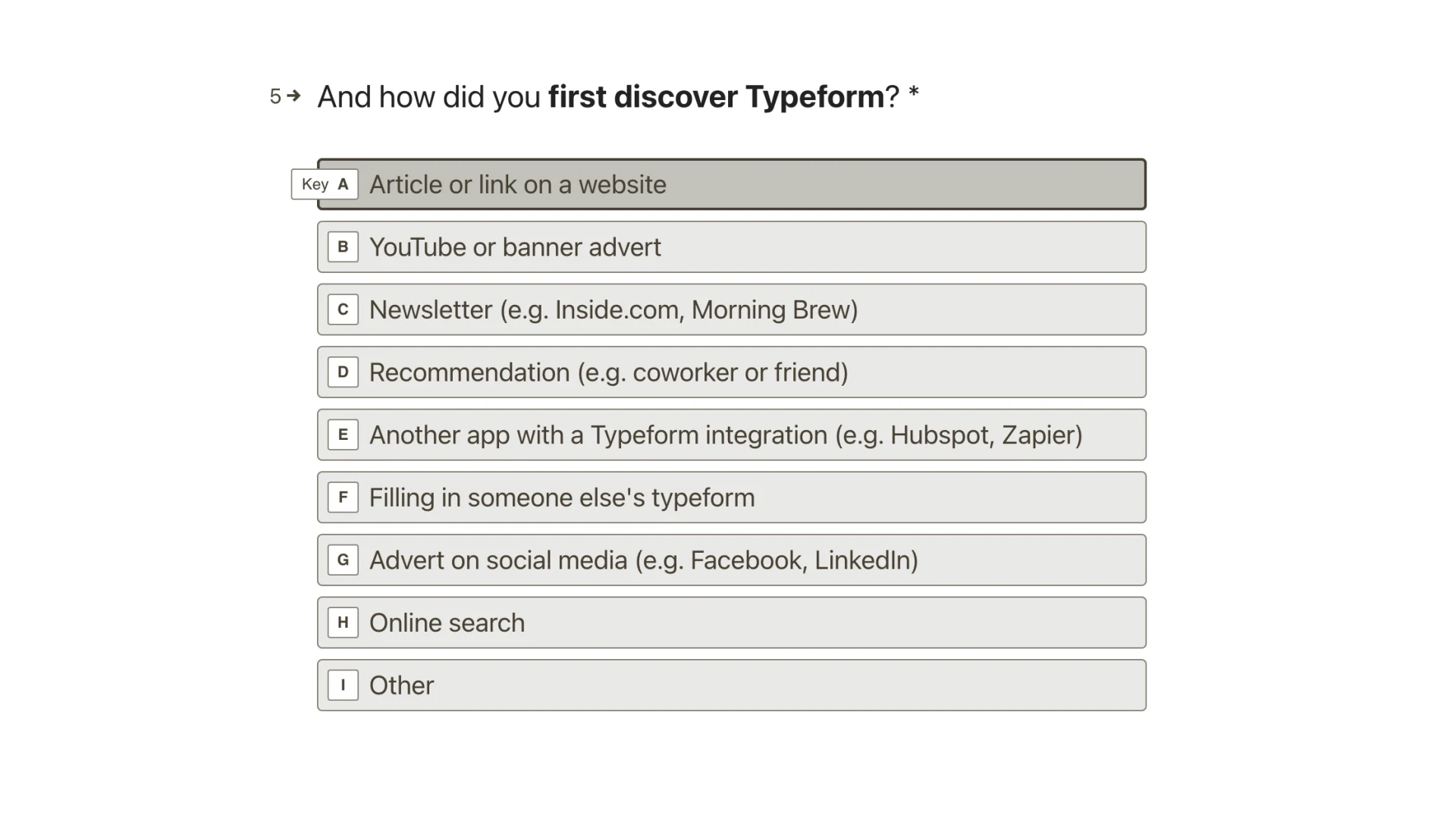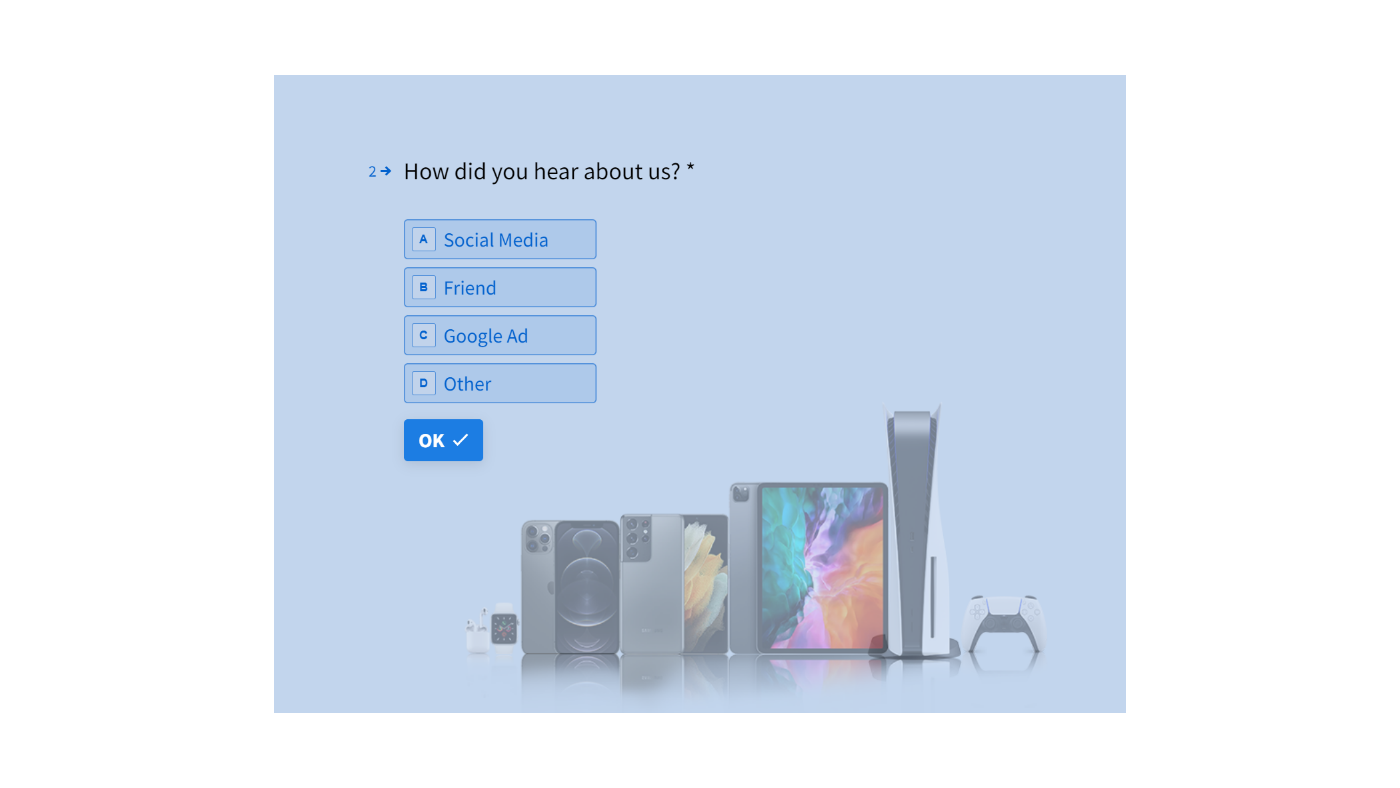Tips
How to leverage zero-party data for marketing attribution
The cookieless future is here, so how are marketers supposed to correctly assign attribution, build informed strategies, or understand their customers? Zero-party data is your friend: learn how to collect and leverage it with this guide.

Cookies are disappearing. Attribution is on its way out.
So, is data-driven marketing over? Are we heading back into the Mad Men era of marketing, with marketers relying on gut instinct and desk-drawer whisky?
In short, not really. What it does mean, is that third-party data, cookie tracking, and number crunching is no longer the be-all and end-all for digital marketers. Instead, it’s time to get back to what marketing is really all about—understanding and engaging with customers.
In other words, it’s the era of zero-party data.
In this guide, we’ll break down:
- What zero-party data really is, and how it differs from first-party data
- Creative and effective ways to collect zero-party data
- How to leverage zero-party data for marketing attribution
What is zero-party data?
Zero-party data is data that someone gives you voluntarily. For instance, if a customer completes a “How did you hear about us?” form, they’ve just given you zero-party data.
Some people group zero-party data in with first-party data, which is data about your prospects that you can collect from your own sources (like your company website, apps, or social media channels). But we think it’s worth making a distinction between them:
There are many types of zero-party data, from user contact details to their product preferences, and so much more. In this article, we’re focusing on one of the most critical data points for marketing teams—attribution.
Using zero-party data for marketing attribution
Quick refresher: marketing attribution is the process of identifying what brought a person to your company (typically your website). In recent years, attribution has become a major component of digital marketing strategy. However, developments in data privacy (e.g., GDPR in the EU and the CCPA in California), the increasing dominance of “dark social”, and new tracking limitations from Google and Apple are making attribution much trickier.
If you can’t use cookies to track user behavior through multiple touchpoints, zero-party data is invaluable. Instead of spying on your prospects and customers to understand how they found you, just go right ahead and ask them. Gathering customer feedback via attribution surveys (the old “How did you hear about us?” form) can provide you with vital user data—without creeping people out.
Here’s what our form looks like, for instance:
The challenge here is that self-reported attribution can be harder to get; not everyone has the time or patience to fill out a survey, no matter how quick or well-designed it is.
With zero-party attribution data, what you lose in quantity you make up for in quality. After all, even the most sophisticated multitouch attribution model can’t take into account the full range of user behaviors.
Here’s a scenario to illustrate what we mean.
Let' s say someone discovers your brand because someone sent them a blog via LinkedIn. The last click before they landed on your website would be from LinkedIn, so most automated attribution models would classify this as a win for social media.
But the actual trigger that earned the lead was the blog post itself, not LinkedIn. Thank your content marketing lead, not your social media manager.
If you simply had asked the user, " How did you hear about us?”, there’s a good chance you’d get a response like “A friend sent me a blog." Asking your customers for information directly, instead of inferring it, provides more accurate (and more useful) attribution data for informing your marketing strategy
In a cookieless world, it’s time for marketers to get back to understanding people, not data.
How to collect zero-party data for marketing attribution
If you want to learn how your prospects found you, there are numerous ways to ask. Here are just a few suggestions:
Checkout page form: Simply adding a “How did you hear about us?” to your checkout page can help you turn your standard user data collection process into a source of self-reported attribution. Plus, when your customers are already filling in other data to complete the purchase, asking them to fill out one more form is a smoother process.
Post-purchase form: Catching people when they’re feeling most engaged with your company—right after they hit the Buy button—can encourage them to take the time to fill in a quick attribution form. This is where we put our own attribution survey.
In-product forms: If you’re in the SaaS business, building a quick and friendly form right into your product can give you invaluable information about your trial users and nip churn in the bud. Add in an attribution question to make it useful for your marketing team too.
Email: Embed a simple attribution survey into your welcome sequence to get to know your prospects from the word go.
Side note: Typeform makes this incredibly easy to do. Once you’ve created a quick “How did you hear about us” survey, you can simply generate a code to embed it into your email marketing platform. There’s a tutorial here if you want to check it out.
Your sales team: Does your sales team ask every prospect how they found you? If not, you’re missing a trick. After all, these are your ideal targets—so you need to know what drove them to get in touch in the first place. Just make sure you have the means to collect and centralize this user data with your other data sources. For instance, set up a form that your sales team can use during calls, that will integrate with Salesforce, Intercom or a CRM platform.
How to ask for zero-party attribution data
Zero-party data can be marketing gold—but only if you ask the right questions. When it comes to attribution surveys, getting the wording right is crucial. A vague or confusing form will see your users skipping the form altogether, or answering at random.
It can be challenging to design a form that gathers the information you need at the right level of granularity. After all, you can’t list out every single marketing campaign you’re running and ask them which one worked. Here are a few ideas for you to consider:
1. Figure out the minimum number of options you need
If you have a fairly simple marketing strategy, a short list may be enough:
However, once your strategy gets more complex, you may need to make your form longer:
This is definitely a moment for A/B testing. If your response numbers are too low to be helpful, try reducing the number of options.
As an alternative, consider a simple open text box. Yes, you’ll need to spend time parsing the data manually (or find a suitable AI tool to help), but you’re more likely to find answers to your big-picture marketing questions.
2. Randomize the order of options
If you’re continuously showing users options in the same order, you risk getting response bias. Instead, randomize the order of the options you show people to get a more representative data spread.
3. Write like a human
Don’t phrase attribution options in marketer-speak. Users may not know what you mean by “referral,” for instance, but they' ll understand “friend or family.” Keep the language human and skip the jargon. If you’re struggling to sound like a person, not a marketing robot, try reading what you’ve written out loud.
For more ideas on how to sound conversational online, check out our handy guide over here.
4. Don’t ask leading questions
It’s easy to steer users to give you the answers you expect. For instance, let’s say you’ve cut back on Facebook ads and went big on LinkedIn instead. Don’t simply drop Facebook as an option because you assume that leads won’t be coming in from that channel anymore.
5. Prioritize good design
When you’re asking users how they heard about you, you’re asking them for a favor. As a result, you need to keep things appealing and fun so there is more incentive to help you out. An attractive, conversational form can help increase the number of responses you get.
For instance, Modulo, an EdTech app developer and a Typeform customer, saw a direct correlation between designing better forms and the response rate; Modulo sees a 15.2% conversion rate for users who complete their 12-minute feedback form, a whopping 3x the industry average for click-through conversion on landing pages. Plus, 56.7% of users who complete the form opt in to Modulo’s mailing list.
Manisha Snoyer, Modulo founder, attributes part of this success to the Typeform experience and design:
“The seamless user experience definitely helps with people finishing the forms,” she said. “Honestly, it’s pretty fun to fill them out.”
3 ways to leverage zero-party attribution data in your marketing strategy
Once you’ve gathered the information you need from your prospects, it’s time to put the data to use. Here are 3 ways to use zero-party attribution data to make your marketing strategy more effective:
1. Tweak your attribution modeling
If you’ve been relying on third-party data to understand attribution, it’s time to rethink your methods. Incorporate your new, higher-quality zero-party data into your attribution model to create a more holistic view of where leads are really coming from.
Of course, as zero-party data is harder to get, you may only have a small sample. However, if you follow the suggestions in the previous section, you should be able to gather enough information to spot patterns. You’re really looking for indicators rather than absolutes.
For instance, if your model previously showed that the majority of leads were coming in from LinkedIn, but your leads are telling you that they liked a blog they read, it’s not time to scrap LinkedIn altogether! Instead, it might be worth spending some more time promoting your blog via LinkedIn and see what results you get.
2. Pair with artificial intelligence tools to create predictive models
Just because zero-party attribution surveys will give you a smaller data set doesn’t mean that they can’t be useful for informing your strategy.
In a recent experiment published in HBR, H. James Wilson, Paul R. Daugherty, and the rest of Accenture’s innovation team used a small data set to train an AI-based analytics platform. When coupled with human input, even a tiny data sample was enough to refine and improve the results produced by the AI solution.
“This combination of machine learning and human expertise has a significant multiplier effect,” Wilson writes. “Mastering the human dimensions of marrying small data and AI could help make the competitive difference for many organizations, especially those finding themselves in a big-data arms race they’re unlikely to win.”
3. Focus on your customers
If you’re not working with expensive marketing attribution and machine learning platforms, zero-party data can be used much more simply. Spending some time working your way manually through your user responses and producing a qualitative analysis of how they found you can help deepen your knowledge of your target demographics considerably.
Then, use your new-found knowledge about your customers to provide helpful, high-quality content in the places where you know they’ll see it. Personalizing user experiences based on this insight can significantly enhance engagement. Tailoring content, services, or offers to match their preferences or behaviors creates a more personalized experience, fostering a stronger connection.
Additionally, consider integrating a value exchange strategy, offering exclusive benefits or tailored solutions in return for their engagement or data. This not only encourages participation but also strengthens the relationship, promoting a sense of reciprocity and trust.
No cookies? No problem
You no longer need to rely on third-party data to get to know your customers. In fact, by using engaging, conversational forms and surveys to gather zero-party data right from the source, you’ll gain a far richer and more comprehensive understanding of your target market. You can use this to refine your marketing strategy, update your attribution model, and focus your marketing efforts on the channels that your ideal leads prefer.
If you want to collect enough zero-party attribution data to make marketing decisions, you’ll need forms that users want to complete. That’s where Typeform comes in. We make it easy for companies to create conversational, friendly, and beautifully designed forms, quizzes and surveys that people actually enjoy answering—improving your ability to collect and leverage zero-party data, engage with your customers, and improve your marketing tactics.






.png)

